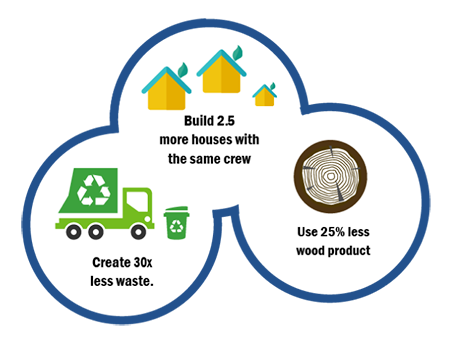Learn Why Components are the Best Way to Frame

Build Faster
Using components allows you to build 2.5 more houses with the same crew
Save Time & Labor
Components are pre-assembled in a facility, enabling quick and efficient installation by a crew with varying experience
Superior Support
Components are engineered and manufactured in a controlled environment using powerful design software and high-quality materials
Create Less Waste
Components use 25 percent less wood product and creates 30X less jobsite waste
Best Way to Frame Calculator
SBCA developed a powerful online calculator as a tool to better understand the possible time and cost savings roof trusses, floor trusses/panels, and wall panels can provide when used instead of conventional stick-framing methods. After inputting a small set of data points unique to a project, the calculator estimates total costs and overall savings.
Stick-Framing vs. Component-Framing: An Apples-to-Apples Framing Comparison
In 2015, two identical 2900 square foot ranch-style houses with a walk-out basement were framed side-by-side. The only difference was one house was entirely stick-framed, while the other home was framed using structural components, including roof trusses, wall panels and floor trusses. These are the results.
| 2015 Test Study | Stick Built | Component | Savings |
|---|---|---|---|
| Total Jobsite Hours to Erect | 375.5 hrs | 152.1 hrs | 223.4 hrs |
| Total Jobsite Waste Generated | 15.0 cubic yds | 0.5 cubic yds | 14.5 cubic yds |
| Total Board Foot Lumber/EWP | 20,643 bd ft | 15,052 bd ft | 5,591 bd ft |
What We Learned
This study suggests that installing roof trusses, wall panels or floor trusses completes the task of framing in less time, requires less framer skill and experience, uses less material and ultimately results in a more reliable structure.
The house built with structural building components was framed in just three days using components. Designed and installed correctly, components allow builders to benefit and greatly reduce the amount of time needed to frame the house compared to traditional stick framing methods. In addition to the savings associated with labor costs, less material overall is used, which shows how components are able to maximize material utilization and reduce the amount of required lumber. The value engineering provided by components makes them environmentally responsible as well, since it ensures that the building industry gets more bang for their buck from the amount of raw material used to resist loads. Ultimately, through triangulation and the principles of engineering, components are able to more efficiently transfer forces than traditional stick framing, which reduces the amount of material, labor, waste, and thus the amount of time necessary to frame a structure.